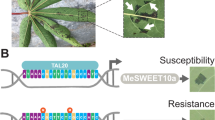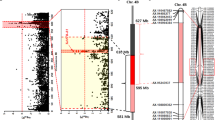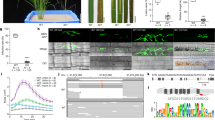Abstract
Transposable elements (TEs) are an important source for generating small interfering RNAs (siRNAs) in plants and animals. Although TE-siRNA-induced silencing of TEs by RNA-directed DNA methylation (RdDM) in the maintenance of genome integrity has been intensively studied, it is unknown whether this type of silencing occurs in suppressing endogenous non-TE genes during host–pathogen interactions. Here we show that a TE-siRNA, TE-siR815, causes opposite functions for the two alleles, WRKY45-1 and WRKY45-2, of the WRKY45 transcription factor in rice resistance to Xanthomonas oryzae pv. oryzae, which causes the most devastating bacterial disease in rice worldwide. Expression of WRKY45-1, but not WRKY45-2, generated TE-siR815, which in turn repressed ST1, an important component in WRKY45-mediated resistance, by RdDM. Suppression of ST1 abolished WRKY45-mediated resistance leading to pathogen susceptibility. These results suggest that TE-siR815 contributes to the natural variation of the WRKY45 locus and TE-siR815-induced suppression of ST1 results in the negative role of WRKY45-1 but positive role of WRKY45-2 in regulating disease resistance.
This is a preview of subscription content, access via your institution
Access options
Subscribe to this journal
Receive 12 digital issues and online access to articles
$119.00 per year
only $9.92 per issue
Buy this article
- Purchase on Springer Link
- Instant access to full article PDF
Prices may be subject to local taxes which are calculated during checkout






Similar content being viewed by others
References
Arikit, S., Zhai, J. & Meyers, B. C. Biogenesis and function of rice small RNAs from non-coding RNA precursors. Curr. Opin. Plant Biol. 16, 170–179 (2013).
Bologna, N. G. & Voinnet, O. The diversity, biogenesis, and activities of endogenous silencing small RNAs in Arabidopsis. Annu. Rev. Plant Biol. 65, 473–503 (2014).
Meyers, B. C. et al. Criteria for annotation of plant microRNAs. Plant Cell 20, 3186–3190 (2008).
Wu, L. et al. DNA methylation mediated by a microRNA pathway. Mol. Cell 38, 465–475 (2010).
Chen, X. A microRNA as a translational repressor of APETALA2 in Arabidopsis flower development. Science 303, 2022–2025 (2004).
Voinnet, O. Origin, biogenesis, and activity of plant microRNAs. Cell 136, 669–687 (2009).
Pelaez, P. & Sanchez, F. Small RNAs in plant defense responses during viral and bacterial interactions: similarities and differences. Front. Plant Sci. 4, 343 (2013).
Wessler, S. R. Transposable elements and the evolution of eukaryotic genomes. Proc. Natl Acad. Sci. USA 103, 17600–17601 (2006).
Lisch, D. How important are transposons for plant evolution? Nature Rev. Genet. 14, 49–61 (2013).
Lu, C. et al. Miniature inverted-repeat transposable elements (MITEs) have been accumulated through amplification bursts and play important roles in gene expression and species diversity in Oryza sativa. Mol. Biol. Evol. 29, 1005–1017 (2012).
Chinnusamy, V. & Zhu, J. K. RNA-directed DNA methylation and demethylation in plants. Sci. China C Life Sci. 52, 331–343 (2009).
Law, J. A. & Jacobsen, S. E. Establishing, maintaining and modifying DNA methylation patterns in plants and animals. Nature Rev. Genet. 11, 204–220 (2010).
Matzke, M., Kanno, T., Huettel, B., Daxinger, L. & Matzke, A. J. Targets of RNA-directed DNA methylation. Curr. Opin. Plant Biol. 10, 512–519 (2007).
Lippman, Z. et al. Role of transposable elements in heterochromatin and epigenetic control. Nature 430, 471–476 (2004).
Liu, J., He, Y., Amasino, R. & Chen, X. siRNAs targeting an intronic transposon in the regulation of natural flowering behavior in Arabidopsis. Genes Dev. 18, 2873–2878 (2004).
Huettel, B. et al. Endogenous targets of RNA-directed DNA methylation and Pol IV in Arabidopsis. EMBO J. 25, 2828–2836 (2006).
Kinoshita, Y. et al. Control of FWA gene silencing in Arabidopsis thaliana by SINE-related direct repeats. Plant J. 49, 38–45 (2007).
Fujimoto, R. et al. Epigenetic variation in the FWA gene within the genus Arabidopsis. Plant J. 66, 831–843 (2011).
Wei, L. et al. Dicer-like 3 produces transposable element-associated 24-nt siRNAs that control agricultural traits in rice. Proc. Natl Acad. Sci. USA 111, 3877–3882 (2014).
Katiyar-Agarwal, S. & Jin, H. Role of small RNAs in host–microbe interactions. Annu. Rev. Phytopathol. 48, 225–246 (2010).
Li, Y. et al. Identification of microRNAs involved in pathogen-associated molecular pattern-triggered plant innate immunity. Plant Physiol. 152, 2222–2231 (2010).
Navarro, L. et al. A plant miRNA contributes to antibacterial resistance by repressing auxin signaling. Science 312, 436–439 (2006).
Zhang, H. & Wang, S. Rice versus Xanthomonas oryzae pv. oryzae: a unique pathosystem. Curr. Opin. Plant Biol. 16, 188–195 (2013).
Tao, Z. et al. A pair of allelic WRKY genes play opposite roles in rice–bacteria interactions. Plant Physiol. 151, 936–948 (2009).
Bureau, T. E., Ronald, P. C. & Wessler, S. R. A computer-based systematic survey reveals the predominance of small inverted-repeat elements in wild-type rice genes. Proc. Natl Acad. Sci. USA 93, 8524–8529 (1996).
Luo, Y. C. et al. Rice embryogenic calli express a unique set of microRNAs, suggesting regulatory roles of microRNAs in plant post-embryogenic development. FEBS Lett. 580, 5111–5116 (2006).
Chen, X. Small RNAs in development — insights from plants. Curr. Opin. Genet. Dev. 22, 361–367 (2012).
Nosaka, M. et al. Role of transposon-derived small RNAs in the interplay between genomes and parasitic DNA in rice. PLoS Genet. 8, e1002953 (2012).
Shimono, M. et al. Rice WRKY45 plays important roles in fungal and bacterial disease resistance. Mol. Plant Pathol. 13, 83–94 (2012).
Sharma, R. et al. Rice cytosine DNA methyltransferases — gene expression profiling during reproductive development and abiotic stress. FEBS J. 276, 6301–6311 (2009).
Cao, X. et al. Role of the DRM and CMT3 methyltransferases in RNA-directed DNA methylation. Curr. Biol. 13, 2212–2217 (2003).
Chan, S. W. et al. RNA silencing genes control de novo DNA methylation. Science 303, 1336 (2004).
Moritoh, S. et al. Targeted disruption of an orthologue of DOMAINS REARRANGED METHYLASE 2, OsDRM2, impairs the growth of rice plants by abnormal DNA methylation. Plant J. 71, 85–98 (2012).
Matzke, M. A. & Mosher, R. A. RNA-directed DNA methylation: an epigenetic pathway of increasing complexity. Nature Rev. Genet. 15, 394–408 (2014).
Cheng, H. et al. The WRKY45-2 WRKY13 WRKY42 transcriptional regulatory cascade is required for rice resistance to fungal pathogen. Plant Physiol. 167, 1087–1099 (2015).
Shimono, M. et al. Rice WRKY45 plays a crucial role in benzothiadiazole-inducible blast resistance. Plant Cell 19, 2064–2076 (2007).
Schauer, S. E., Jacobsen, S. E., Meinke, D. W. & Ray, A. DICER-LIKE1 blind men and elephants in Arabidopsis development. Trends Plant Sci. 7, 487–491 (2002).
Reinhart, B. J., Weinstein, E. G., Rhoades, M. W., Bartel, B. & Bartel, D. P. MicroRNAs in plants. Genes Dev. 16, 1616–1626 (2002).
Liu, B. et al. Loss of function of OsDCL1 affects microRNA accumulation and causes developmental defects in rice. Plant Physiol. 139, 296–305 (2005).
Tao, Z. et al. OsWRKY45 alleles play different roles in abscisic acid signalling and salt stress tolerance but similar roles in drought and cold tolerance in rice. J. Exp. Bot. 62, 4863–4874 (2011).
Jeong, D. H. et al. Generation of a flanking sequence-tag database for activation-tagging lines in japonica rice. Plant J. 45, 123–132 (2006).
Song, X. et al. Roles of DCL4 and DCL3b in rice phased small RNA biogenesis. Plant J. 69, 462–474 (2012).
Cao, Y. et al. The expression pattern of a rice disease resistance gene Xa3/Xa26 is differentially regulated by the genetic backgrounds and developmental stages that influence its function. Genetics 177, 523–533 (2007).
Zhao, J., Fu, J., Li, X., Xu, C. & Wang, S. Dissection of the factors affecting development-controlled and race-specific disease resistance conferred by leucine-rich repeat receptor kinase-type R genes in rice. Theor. Appl. Genet. 119, 231–239 (2009).
Yuan, B., Shen, X., Li, X., Xu, C. & Wang, S. Mitogen-activated protein kinase OsMPK6 negatively regulates rice disease resistance to bacterial pathogens. Planta 226, 953–960 (2007).
Lin, Y. & Zhang, Q. Optimising the tissue culture conditions for high efficiency transformation of Indica rice. Plant Cell Rep. 23, 540–547 (2005).
Chen, H., Wang, S. & Zhang, Q. New gene for bacterial blight resistance in rice located on chromosome 12 identified from Minghui 63, an elite restorer line. Phytopathology 92, 750–754 (2002).
Dalmay, T., Hamilton, A., Mueller, E. & Baulcombe, D. C. Potato virus X amplicons in Arabidopsis mediate genetic and epigenetic gene silencing. Plant Cell 12, 369–379 (2000).
Qi, Y., Denli, A. M. & Hannon, G. J. Biochemical specialization within Arabidopsis RNA silencing pathways. Mol. Cell 19, 421–428 (2005).
Gruntman, E. et al. Kismeth: analyzer of plant methylation states through bisulfite sequencing. BMC Bioinformatics 9, 371 (2008).
Acknowledgements
We thank Y. Qi (Tsinghua University), X. Cao (the Institute of Genetics and Developmental Biology), G. An (Kyung Hee University) and D. Zhou (Huazhong Agricultural University) for kindly providing rice seeds, RDR2, DCL and DRM2 RNAi lines or mutants and the sRNA PAGE–northern protocol. We also thank C. Zhou for help with DNA methylation analysis. This work was supported by grants from the National Natural Science Foundation of China (grant nos 31471757 and 31200912) and the National Program on the Development of Basic Research in China (grant no. 2012CB114005).
Author information
Authors and Affiliations
Contributions
H.Z. designed the study, conducted most of the experiments, analysed the data and drafted the manuscript; Z.T., H.H., Z.C. and C.W. helped to generate some transgenic plants and small RNA sequencing; J.X. and X.L. provided biochemical and molecular analysis support and management; and S.W. designed and supervised the study, interpreted data and revised the manuscript. All authors read and approved the manuscript.
Corresponding author
Ethics declarations
Competing interests
The authors declare no competing financial interests.
Supplementary information
Rights and permissions
About this article
Cite this article
Zhang, H., Tao, Z., Hong, H. et al. Transposon-derived small RNA is responsible for modified function of WRKY45 locus. Nature Plants 2, 16016 (2016). https://doi.org/10.1038/nplants.2016.16
Received:
Accepted:
Published:
DOI: https://doi.org/10.1038/nplants.2016.16
This article is cited by
-
An overview of the roles of critical insiders and outsiders for reciprocal plant–microbe interaction: Heterotrimeric G-proteins, small RNAs, pollinators, microalgae
Symbiosis (2024)
-
Disease resistance conferred by components of essential chrysanthemum oil and the epigenetic regulation of OsTPS1
Science China Life Sciences (2023)
-
DNA methylation dynamics in response to abiotic and pathogen stress in plants
Plant Cell Reports (2022)
-
Contribution of Small RNA Pathway to Interactions of Rice with Pathogens and Insect Pests
Rice (2021)
-
Genome-Wide Association Study Dissects Resistance Loci against Bacterial Blight in a Diverse Rice Panel from the 3000 Rice Genomes Project
Rice (2021)



